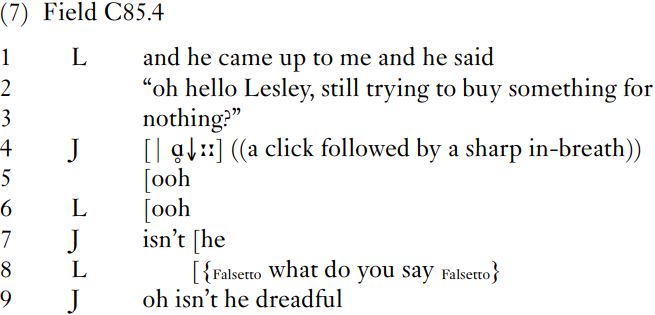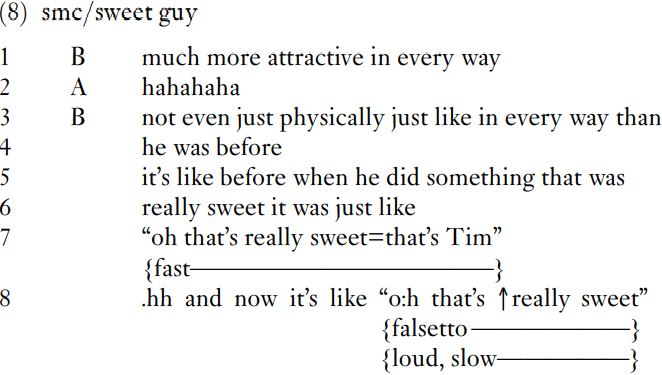
Falsetto
 المؤلف:
Richard Ogden
المؤلف:
Richard Ogden
 المصدر:
An Introduction to English Phonetics
المصدر:
An Introduction to English Phonetics
 الجزء والصفحة:
52-4
الجزء والصفحة:
52-4
 16-6-2022
16-6-2022
 916
916
Falsetto
Falsetto involves the raising of a speaker’s average f0 to way beyond their normal range. To produce falsetto, the vocal folds are stretched and lengthened and the glottis is not completely closed. Falsetto can be used in singing, but also occurs in conversational speech. The IPA has no symbol for marking falsetto.
Here are two cases of falsetto from everyday talk. The first one is part of a complaint from Lesley to her friend Joyce about an acquaintance of theirs, who has offended Lesley. At line 8, she goes into falsetto, probably marking some kind of stance such as ‘outrage’ at the way she has been treated.

The second example is a woman describing to a friend her feelings towards a man. She compares her earlier stance towards him with her current view of him: she is now much more favorably disposed towards him than she was. She uses the same words to express her stance towards him, but the second time round, she speaks in falsetto, as well as speaking much more slowly and loudly.

In both of these examples, by moving into falsetto, the speaker is able to use a higher pitch range than her normal one, which means that the difference between the highest and lowest values of the f0 range is expanded. The high pitches the speakers can reach (as high as 673 Hz in the first example and 572 Hz in the second one) may be used to mark out their current talk as conveying something ‘noteworthy’, or something that the other person is expected to comment on. In both these cases, the speakers are involved in presenting a strong stance towards the person they are talking about: in the first case as part of a complaint, and in the second case as part of a positive, upgraded stance as compared to an earlier one. Perhaps falsetto is used to mark an attitude towards the subject matter which is at one extreme or the other – but not neutral.
 الاكثر قراءة في Phonetics
الاكثر قراءة في Phonetics
 اخر الاخبار
اخر الاخبار
اخبار العتبة العباسية المقدسة


